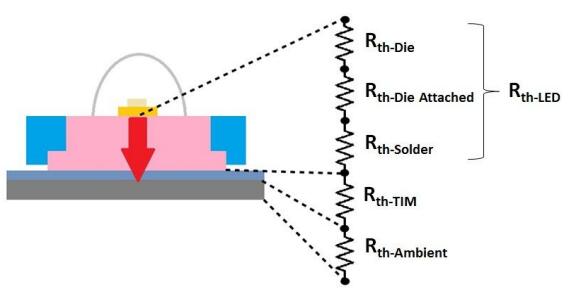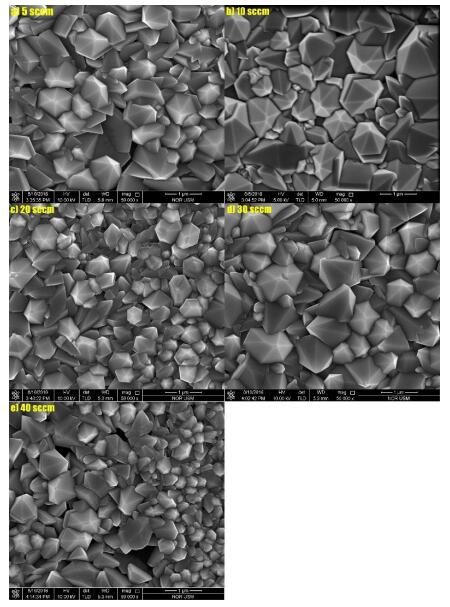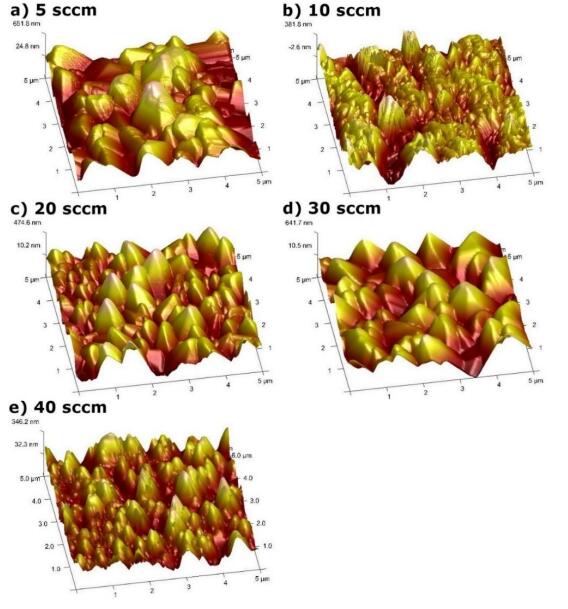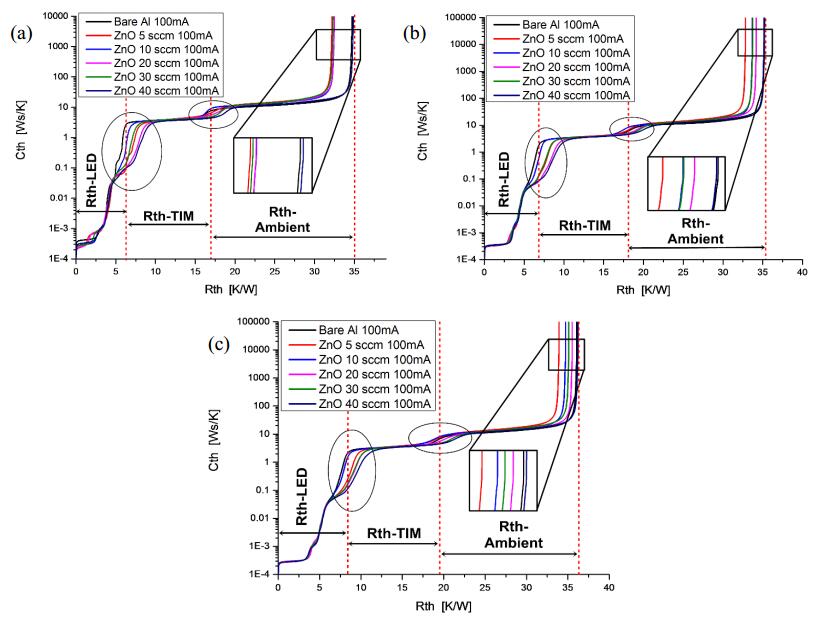1. Introduction
Thermal management has emerged as one of the major bottlenecks in the field of high-performance Light Emitting Diodes (LEDs). The miniaturization of LEDs affected the lifetime and reliability of these devices. The heat sinks play a vital role as cooling solutions while the LEDs are usually mounted on external heatsinks to ensure enhanced heat dissipation system. However, as two mating surfaces of LED and heat sinks usually filled with a thin layer of air-gap, very low thermal conductivity of air (0.020 W/mK) distracted the heat flow between the device and the heatsink, hence increased the thermal resistance (Rth) of the LED [1]. One of the solutions that have been identified recently was applying thermal interface materials (TIMs) to fill the gap and irregularities to improve the heat dissipation [2] and hence the performance of the LEDs can be sustained [3].
The basic function of TIM is to provide effective thermal path between different substrates. However, the commercially available TIMs like thermal grease, thermal paste, and polymer based adhesives such as epoxies and silicones [4,5] were prone to drawbacks such as pump-out or dry-out of the material [6]. It has been reported elsewhere that thermal pastes can cause problems due to its limited stability in the phase segregation and paste squeezing [7]. It has also been reported that these polymers-based TIMs were also prone to crack propagation of the glue layer at high temperature operations [8]. Consequently, the ineffective TIMs caused the thermal performance of LEDs to raise the junction temperature (Tj) and Rth and eventually leading to severe catastrophic failure of the devices.
As such, recently the usage of solid thin films as TIMs for thermal management solution caught interest among researchers. Ong et al. reported that optimized Boron doped Aluminium Nitride thin films coated on copper substrate through DC-RF coupled sputtering helped in reducing the Tj and Rth of the LEDs performance when applied as TIMs [9]. Meanwhile, Lim et al. investigated the influence of annealed Cu-Al2O3 thin film on the performance of high power LED and observed the reduction of LED Tj of about 4.59 ℃ [10]. It has been reported by the same author group that Ag and Ni thin films were prepared by sputtering technique [11] and used for TIM purposes where a significant improvement on the LED performance was reported. Chowdury et al. conducted a study on the usage of thin film as thermoelectric cooler and reported the improvement upto 15 ℃ at the targeted region on Si test chip [12]. The performance of Al2O3 thin film as TIM for high power LED was investigated by one of the author and the results showed lower thermal resistance and junction temperature value when compared with the performace from sample without TIM [13]. Dinash et al. studied the effect of different thickness and pressure applied on Al2O3 as TIM deposited on Copper substrate. It was observed that the thin film thermal conductivity improved at high pressure due to increase in contact area [14]. Hence, from all the recent researches shown, solid thin film as TIM is proven to be a better solution for thermal management in electronic application.
Among the thin films considred as TIM, recently, zinc oxide (ZnO) has received much attention for their excellent electro-optical properties, wide band gap between 3.2 and 3.4 eV at room temperature, large exciton binding energy (60 meV) and high mobility [15]. ZnO has been used in several applications such as gas sensor [16], LEDs [17], transistors [18] and transparent electrodes in solar cells [19]. In addition, as stated by the same author, ZnO thin film was deposited by RF sputtering at various thicknesses and considered as a good TIM with its performance on reducing the Rth and Tj of high power LEDs [7,20,21,22]. Among the materials used in the solid state TIM, materials such as AlN and BN were considered as intricate and complicated to deposite. ZnO on the other hand is proven to be very easy and cost effective thin film to be deposited. There are few researchers reported on ZnO thin film synthesis and used as thermal interface material with noticeable improvement in reducing the Tj values of device, but they used sputtering for film deposition which will increase the production cost of material as well as end product. It is necessary to indentify an alternative method to deposit ZnO thin film on various substrates and study their performance on LED thermal management. In this study, low cost deposition technique was chosen to overcome the problem.
For various applications, considerable efforts had been made to obtain high quality ZnO thin film using variety of deposition processes such as chemical vapor deposition (CVD) [23], pulse laser deposition [24], spin coating [25], electron beam deposition [26], RF magnetron sputtering [27], spray pyrolysis [28] and atomic layer deposition [29]. Among these techniques, the CVD method had become rousingly popular due to its advantage of being able to produce high-quality ZnO film at lower cost, besides the ability to generate the thin films in mass production [23] and used in this study for the deposition of ZnO thin film on Al substrates at different flow rate of oxygen gas. The main goal of this study was to investigate the effect of oxygen (O2) gas flow rate on the growth of ZnO thin films and their influence on reducing the Tj and Rth of the LED. Surface analysis was also done using AFM and FESEM to evaluate the surface roughness of coated thin films. In this study, the ZnO thin film was considered as TIM between Al substrate and base of LED package and recorded thermal transient curve using thermal transient analysis approach.
2. Materials and method
ZnO thin films were deposited on Al substrates (25 mm × 25 mm × 1.5 mm) by chemical vapor deposition method at various gas flow rate. High purity zinc acetate dihydrate [Zn(CH3COO)2·2H2O, 98%] from Sigma Aldrich was used as precursor. Prior the deposition, the substrates were cleaned by immersing in ethanol bath using ultrasonic cleaner. A three zone CVD furnace attached with quartz tube (OTP-1200X-Ⅲ) was used for the deposition of the thin films. The cleaned substrates were then loaded into the quartz tube and placed at the centre zone (reaction zone). Approximately 4 g zinc acetate dihydrate [Zn(CH3COO)2·2H2O] powder was placed at the left zone and used as precursor to be decomposed throughout the experiment. The CVD tube was evacuated using rotary vacuum pump to maintain inert atmosphere inside the tube throughout the heating process. The tube was then filled with O2 with various flow rate, and it act as carrier gas to help to transfer the reactive material vapor from one zone to the other. The coating process was carried out for about 30 min under atmospheric pressure. The detailed parameters used in this study are presented in Table 1.
Table 1. Synthesis material and parameters for ZnO thin film by CVD method.
| Parameter |
Condition |
| Precursor |
Zinc Acetate Dihydrate |
| Precursor temperature |
300 ℃ |
| Substrate |
Aluminium |
| Substrate temperature |
400 ℃ |
| O2 flow rate |
5 sccm, 10 sccm, 20 sccm, 30 sccm, 40 sccm |
| Deposition time |
30 min |
The thermal performance of LED attached on ZnO thin film (thermal interface) coated Al substrates was measured by thermal transient tester (T3ster). The surface behaviour of ZnO thin film was analysed by AFM and FESEM, such as surface morphology, roughness and elemental composition. The average thickness was measured from the cross sectional thin film using FESEM and presented in Table 2.
Table 2. Film thickness and film roughness of ZnO thin film by CVD method.
| Sample |
Film Thickness (nm) |
Roughness (nm) |
| ZnO 5 sccm |
876 |
158 |
| ZnO 10 sccm |
1486 |
83 |
| ZnO 20 sccm |
746 |
106 |
| ZnO 30 sccm |
1765 |
153 |
| ZnO 40 sccm |
440 |
72 |
2.1. Thermal transient analysis
Thermal transient characteristics of 3.5 W warm white golden dragon LED fixed on different thicknesses of ZnO thin films on Al substrates were measured. The testing was done based on electrical test method JEDEC JESD51-51 [30]. A detailed measurement procedure has already been reported by the same author group in another work [7]. Briefly, LED calibration was thermally calibrated to obtain the LED K-factor of the LED and observed that K value was 1.563 mV/℃ from the graph of junction voltage (voltage drop) against ambient temperature. Still air chamber (300 × 300 × 300) mm was used for all the experiments to satisfy the JEDEC JESD 51-2A standards on natural air convection measuring method [31] at room temperature of 25 ± 1 ℃. During the testing, the LEDs were forward biased for 900 s (heating process) and the thermal transient cooling curve was recorded for another 900 s once the LED attained steady state. Transient analysis was carried out at three different driving currents (100,350,700 mA). The transient curve was captured three times for all samples to ensure the repeatability where the observed differences in each measurement was low (±0.05 K/W) and acceptable.
A schematic diagram of thermal resistance network (1D resistor model) for an LED mounted on ZnO coated Al substrates is provided in Figure 1 to illustrate the layers in the system where resistance is created as the heat flows from one layer to another. It is important to verify the individual layers in the system and their resistance to identify the regions of interest for efficient thermal management using structure functions. From Figure 1, we can understand the interpretation of the cumulative structure functions as given in Figure 4 under Section 3.3.
3. Result and discussion
3.1. Surface characterization—FESEM analysis
To study the effect of thin film growth of ZnO thin film at different gas flow rate, surface micrographs were captured by FESEM. Figure 2 shows SEM micrograph of ZnO thin film deposited at different O2 flow rate. Overall, the pyramid-like structure can be seen in all samples irrespective to the gas flow rates. From Figure 2, it clearly shows that the size of the particles was not uniform and not well-distributed in all thin film surfaces. Particle density in surface changed with inclination of gas flow rates and dense particle surface for ZnO thin film was seen at 5 sccm which was favourable for good thermal conduction. Loosely bounded particles could be observed on the film surface which were processed by using 20 and 40 sccm flow that can affect the heat flow due to the improper contact between the particles. Large structured particles were noticed with thin film samples processed at 30 sccm, hence created possible deep valleys that are not desirable for heat conduction. Large pyramid structured particles were also noticed for 10 and 30 sccm sample in which poor heat conduction was expected due to the possible deep valleys and inconsistent film structure. According to the results published in Ref. [32], the presence of impurities and defects were lower for thicker film, thus lower thermal resistance was expected with greater thickness.
Considering the 20 sccm sample, the film structure has the composition of loosely bounded particles on the surface which is not suitable for surface conduction. At 40 sccm, although the surface was uniform the particles were found to be very smallest which can increase the contact points, hence high contact resistance was viable. Using elemental analysis, the weight% of elements presented in Table 3, the synthesized ZnO thin film was measured and it was observed that ZnO thin film was rich with Zn.
Table 3. Weight percentage of Zn and O elements of ZnO thin film by CVD method.
| Element |
bulk |
5 sccm |
10 sccm |
20 sccm |
30 sccm |
40 sccm |
| O |
19.66 |
16.96 |
14.63 |
16.86 |
15.43 |
17.06 |
| Zn |
80.34 |
83.04 |
85.37 |
83.14 |
84.57 |
82.94 |
3.2. AFM analysis
To strengthen the above observation, AFM was used to capture the surface morphology and analyse the contact resistance of ZnO thin film. The captured 3D images were analyse and presented in Figure 3.
The surface roughness was measured using Nanoscope software and summarized in Table 2. From the Table 2, high and low values of RMS surface roughness were measured for thin film processed at 5 sccm and 40 sccm respectively. The surface roughness values play a vital role on changing the thermal conduction via surface contact points. ZnO thin film performed at 40 sccm showed low surface roughness value followed by 10 sccm samples. The same authors reported the influence of film thickness and surface roughness of ZnO thin film prepared by sputtering process and observed good performance with low surface roughness [20]. Generally, high surface roughness will result in poor thermal contact conductance [33]. Contrarily, low Rth was noticed with high surface roughness for ZnO thin film prepared at 5 sccm flow of O2. This might be due to the good thermal conductivity behaviour of ZnO thin film.
3.3. Cumulative structure function analysis
Figure 4 shows the cumulative structure function of LED mounted on ZnO coated Al substrate. Structure functions show the thermal profile recorded from the point of heat generation to the ambient. As illustrated in Figures 1 and 4, the system consists of 3 main parts: the first part shows the Rth-LED comprises of Rth-die, Rth-die attached and Rth-solder, respectively. According to datasheet for white golden dragon, the Rth value was measured to be in the range of 5–6.4 K/W. The second part shows the Rth-TIM refers to the Rth of ZnO thin film. Lastly, Rth-ambient shows the measured resistance from the Al substrate to ambient. From the graph, it is easy to analyse the effect of heat transfer from one layer to the other in terms of increasing or decreasing of Rth value.
Figure 4 depicted clearly that bare Al and 40 sccm sample showed the highest distinct value of Rth-tot among all of other boundary conditions. It is also seen from Figure 4 that there were interface resistance observed for all boundary conditions (solid line circle in Figure 4). It was found that Rth-tot value in 5 sccm boundary conditions. It was expected that the optimized surface contact points of the thin film with the surface of LED effectively improved the heat transfer, thus gave low Rth-tot value.
To discuss in detail, the Rth-tot values are presented in Table 4. From Table 4, all ZnO thin film coated on Al substrates performed well to noticeably reduce the Rth-tot except for thin film prepared at 40 sccm. An increasing trend in Rth-tot values was noticed for the samples prepared at 5 sccm to 20 sccm for all driving currents. Overall, the reducing values of Rth-tot of the device were observed for ZnO thin film boundary conditions. A clearer difference of Rth-tot (2.1 W/K) was seen for 5 sccm thin film boundary condition when compared withbare Al boundary condition. This value is smaller than the observed Rth-tot value for sputtered ZnO thin film in another finding [21].
Table 4. Rth-tot and Tj values of LED for various flow rate of O2 boundary conditions.
|
Bare Al |
ZnO 5 sccm |
ZnO 10 sccm |
ZnO 20 sccm |
ZnO 30 sccm |
ZnO 40 sccm |
| Junction to ambient Thermal Resistance, Rth-tot (K/W) |
| 100 mA |
34.73 |
32.20 |
32.48 |
32.48 |
32.33 |
34.85 |
| 350 mA |
35.21 |
32.78 |
33.69 |
34.19 |
33.42 |
34.50 |
| 700 mA |
36.06 |
33.92 |
34.72 |
35.51 |
35.11 |
35.68 |
| Junction Temperature, Tj (℃) |
| 100 mA |
9.5 |
8.9 |
9 |
9 |
9 |
9.6 |
| 350 mA |
36.6 |
34.1 |
35.1 |
35.6 |
35.1 |
36.6 |
| 700 mA |
79.5 |
74.7 |
76.6 |
78.2 |
77.3 |
79.9 |
As represented in Figure 4, the ZnO thin film prepared at 40 sccm showed the highest Rth-tot among all other flow rate boundary conditions which is close to bare Al boundary conditions. Lower Rth-tot value was possible when number of contact points increased in which it was observed at 5 sccm samples and proved by FESEM. A sudden decrease of Rth-tot for 30 sccm samples was seen due to the bigger size particles on the dense film surface which can reduce the contact resistance and improve the heat conduction though it had higher film thickness. Overall, lower thermal resistance was found for ZnO thin film compared to the bare Al substrate. It is attributed to impurities and defects in the prepared films [32]. Lower value in film thickness was measured for 40 sccm samples but the surface consisted of big and small particles with voids. Although it has low surface roughness, the Rth-tot values were high because of the number of contact points made with the bottom surface of LED package, thus created high contact resistance. Regarding the effect of driving current, 5 sccm samples showed the least increment in Rth-tot value when compared with all other boundary conditions. Bare Al and 40 sccm boundary condition had not been considered since it has high Rth-tot values which were not preferred for good performance.
3.4. Junction temperature analysis
Table 4 shows the Tj recorded for various boundary conditions to study the influence of ZnO thin film on the LED performance. From Tj values, the lifetime as well as the degradation of the LED can be analysed and determined. As observed from Rth-tot values, measured Tj values followed the same trend, showing low Tj for 5 sccm boundary conditions. The calculated ΔTj value was 4.8 ℃ for 5 sccm boundary condition, in which it showed lower value compared with bare Al boundary condition which is comparatively low for sputtered ZnO thin film with 200 nm thickness reported in another work [20]. However, the observed value was higher than the reported value for 800 nm ZnO thin film when the thermal interface material was prepared by sputtering process [22]. ZnO thin film prepared at 5 sccm has film thickness of 876 nm and comparatively perform better than sputtered ZnO thin film.
Increasing driving currents, 5 sccm sample showed the best performance on reducing the Tj value among all other samples considered in this analysis and increased the device temperature up to 74.7 ℃. The 5 sccm sample conducted more heat from the LED junction to the ambient among other boundary conditions. The ZnO thin film prepared at 40 sccm has low film thickness with undesired surface structure, hence heat accumulation occurred at the interface due to current crowding effect at high driving currents. Tj analysis also supported the observation made with Rth-tot, thus ZnO thin film prepared at 5 sccm would be an alternative to commercial thermal interface materials.
4. Conclusions
ZnO thin film coated on aluminium substrates via CVD method at various flow rates of O2 was used as solid thermal interface material (TIM) for high power LED. Thermal transient method was used to evaluate the performance of thin film towards the changing of Rth-tot and Tj of LED. Lower values of Rth-tot and Tj were recorded at 5 sccm thin film boundary condition and clearer improvement of the reduction of Rth-tot and Tj values were also observed when compared with bare Al boundary condition. ZnO thin film processed through CVD performed better than sputtered thin film. FESEM and AFM images of ZnO thin films supported and confirmed the observed data by thermal transient method. Overall, CVD method would be an effective and alternative method with sputtering method base on the quality ZnO thin film with reasonable cost for the preparation of thermal interface material for high power LED.
Acknowledgments
This work was financially supported by Collaborative Research in Engineering Science and Technology (CREST) under grant (304/PFIZIK/650788/C121).
Conflict of interest
The authors declare that there is no conflict of interest regarding the publication of this manuscript.









 DownLoad:
DownLoad: 










